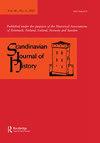The last hunger years? The 1826–1832 mortality crisis in Denmark
IF 0.8
3区 历史学
Q1 HISTORY
引用次数: 0
Abstract
ABSTRACT From 1826 and the six years following, Denmark underwent a severe mortality crisis. The conventional understanding is that it was caused by a malaria epidemic, although recent literature has challenged this. This study examines the demographic and clinical features of this mortality crisis to understand it further. The crisis began in Langeland in 1826 and spread throughout most of Zealand and Lolland-Falster in the following years with a dramatic culmination in the autumn of 1831. In addition to a lethal measles and scarlet fever epidemics in the spring of 1829, the affected regions experienced returning lethal epidemics during harvest in this period. The complex of symptoms during these epidemics resembles enteric infections such as typhoid fever, paratyphoid or E. coli, and typhus fever. In the same period, Denmark also underwent a subsistence crisis from several years with crop failures. The mortality crisis, and namely the harvest epidemics, was probably related to this subsistence crisis. A scarcity of fresh food meant that the rural population ate contaminated food products, making them ill. The crisis thereby exemplifies the synergetic relationship between epidemics and subsistence crises that were common before the breakthrough of the demographic transition in the 19th century.上一个饥饿年代?1826-1832年丹麦的死亡率危机
摘要从1826年到随后的六年,丹麦经历了一场严重的死亡危机。传统的理解是它是由疟疾流行病引起的,尽管最近的文献对此提出了质疑。这项研究考察了这场死亡危机的人口统计学和临床特征,以进一步了解它。这场危机始于1826年的兰格兰,并在接下来的几年里蔓延到新西兰大部分地区和洛兰-福尔斯特,1831年秋天达到了戏剧性的高潮。除了1829年春季致命的麻疹和猩红热流行病外,受影响地区在这一时期的收获期间还经历了致命流行病的复发。这些流行病期间的复杂症状类似于伤寒、副伤寒或大肠杆菌以及伤寒等肠道感染。在同一时期,丹麦也经历了几年的粮食歉收带来的生存危机。死亡危机,即收割流行病,可能与这场生存危机有关。新鲜食物的短缺意味着农村人口食用了受污染的食品,使他们生病。因此,这场危机体现了流行病和生存危机之间的协同关系,这种关系在19世纪人口结构转型突破之前很常见。
本文章由计算机程序翻译,如有差异,请以英文原文为准。
求助全文
约1分钟内获得全文
求助全文
来源期刊

SCANDINAVIAN JOURNAL OF HISTORY
HISTORY-
CiteScore
1.10
自引率
20.00%
发文量
33
期刊介绍:
Scandinavian Journal of History presents articles on Scandinavian history and review essays surveying themes in recent Scandinavian historical research. It concentrates on perspectives of national historical particularities and important long-term and short-term developments. The editorial policy gives particular priority to Scandinavian topics and to efforts of placing Scandinavian developments into a larger context. Studies explicitly comparing Scandinavian processes and phenomena to those in other parts of the world are therefore regarded as particularly important. In addition to publishing articles and review essays, the journal includes short book reviews. Review essay proposals and polemical communications are welcomed.
 求助内容:
求助内容: 应助结果提醒方式:
应助结果提醒方式:


